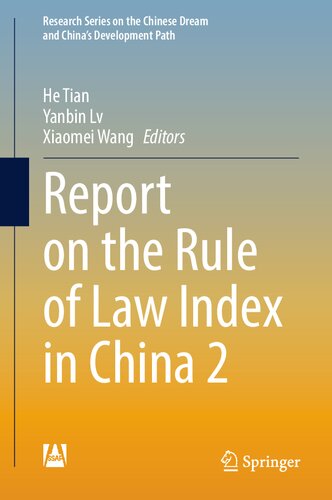

Most ebook files are in PDF format, so you can easily read them using various software such as Foxit Reader or directly on the Google Chrome browser.
Some ebook files are released by publishers in other formats such as .awz, .mobi, .epub, .fb2, etc. You may need to install specific software to read these formats on mobile/PC, such as Calibre.
Please read the tutorial at this link: https://ebookbell.com/faq
We offer FREE conversion to the popular formats you request; however, this may take some time. Therefore, right after payment, please email us, and we will try to provide the service as quickly as possible.
For some exceptional file formats or broken links (if any), please refrain from opening any disputes. Instead, email us first, and we will try to assist within a maximum of 6 hours.
EbookBell Team

4.8
14 reviewsThis book reviews and assesses the status quo concerning the rule of law in China in 2017 and predicts its future development in such fields as legislation, judicial reform, civil, commercial and economic law, social law, safeguarding of human rights, criminality, Internet finance, the securities market, pilot free trade zones, administrative public interest litigation, regulation of investment management business, and AI.
The book consists of a series of reports on the assessment of rule of law carried out by the Innovation Project Team on the Rule of Law Index at the Institute of Law, Chinese Academy of Social Sciences. Drawing on data from web portals and using the methods of browsing websites and verifying results through phone calls, the book includes assessment reports on the government transparency of 54 departments under the State Council and the governments of 31 provinces (autonomous regions and municipalities directly under the Central Government), 49 larger cities, and 100 counties (cities and districts).
In addition, reports are provided on the judicial transparency of the Supreme People’s Court, 31 higher people’s courts, and the intermediate people’s courts of 49 larger cities, the procuratorial transparency of the Supreme People’s Procuratorate and people’s procuratorates of 31 provinces (autonomous regions and municipalities directly under the Central Government) and 49 larger cities, as well as the maritime judicial transparency of 10 maritime courts in the country. The book also includes reports on disclosure of information and transparency in the public security organs of four municipalities directly under the Central Government and 27 provincial (autonomous regional) capitals.
Given its scope, the book offers a valuable asset for legal scholars, lawyers, judges, prosecutors, graduate and undergraduate students, and all those who are interested in Chinese law and the country’s rule of law index.